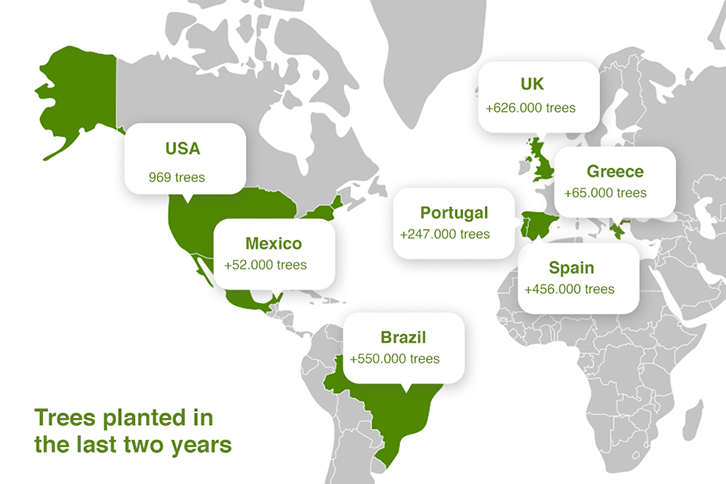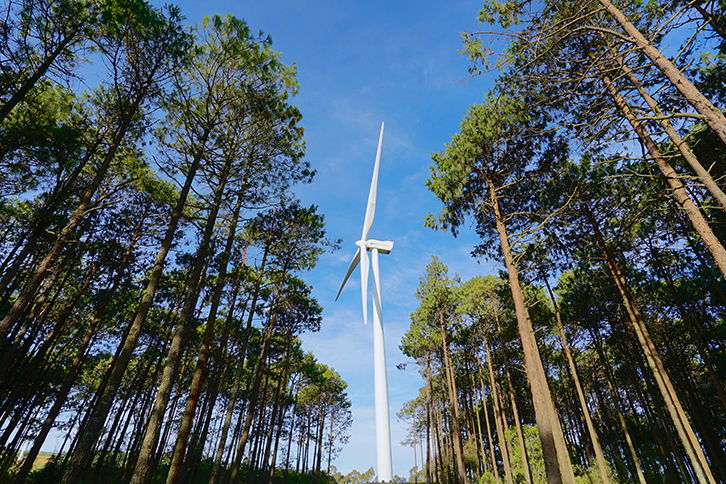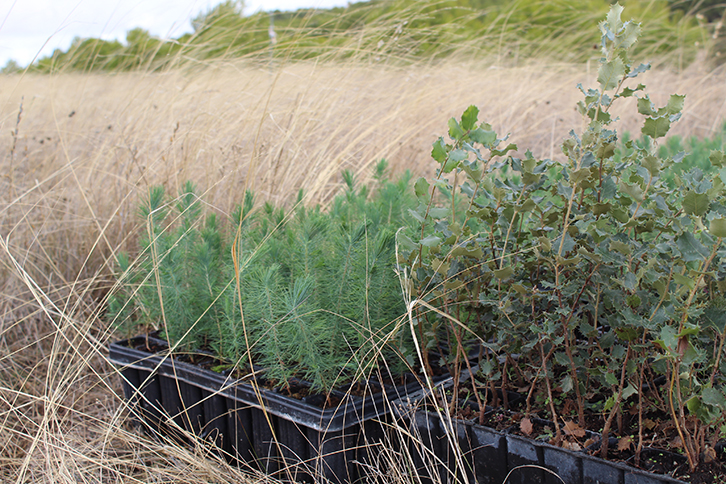News
MARCH 21: INTERNATIONAL FOREST DAY
Iberdrola reforests with more than 2 million trees in the last two years and 80,000 plants in photovoltaic environments
- Iberdrola is committed to promoting biodiversity and seeks to preserve and regenerate healthy ecosystems in its projects.
- Nearly 80,000 trees and plants are being planted in the surroundings of Iberdrola's photovoltaic plants in Spain
In the last two years, the Iberdrola group has planted more than 2 million trees in seven countries. The reforestation activities are part of its ambitious Tree Programme, which involves its corporate volunteer network around the world.
The Trees Programme, which began in 2020, is a demonstration of Iberdrola's commitment to the conservation and regeneration of forest ecosystems as a measure to halt deforestation and promote the biodiversity of ecosystems in the areas where the company operates, and therefore aims to promote the planting of 20 million trees by 2030 - with an initial target of 2.5 million by 2022 and 8 million by 2025 - which will capture approximately 6 million tonnes of CO2 over 30 years.
Commitment to a greener world
In Spain, the planting of more than 456,000 trees has been promoted in the last two years. Of particular note are the reforestations around the Cortes - La Muela and Villarino hydroelectric power stations, covering 600 hectares. In addition, 17,000 trees have been planted at the Chinchilla Training Centre in Albacete and various volunteer initiatives have been promoted that have allowed more than 6,800 trees to be planted.
The British subsidiary of the Group, ScottishPower, has contributed to the planting of more than 626,000 trees through reforestation actions in the Habitat Management and Monitoring Plan for the wind farms at Kilgallioch, Hare Hill Extension, Glen App, Black Law, Mark Hill, and Beinn Tharsuinn. In addition, Corporate Volunteering actions have been carried out where 420 trees have been planted in Glasgow and Scottish Highlands.
In Brazil, Neoenergia has promoted the planting of around 550,000 trees, of the more than 817,000 that were planted in total. Especially for the creation of Permanent Preservation areas in the surroundings of hydroelectric plants and in the reforestation of its distributors, in which 82 hectares were reforested with more than 100,000 trees of plants native to the region.
In the United States, AVANGRID contributed to the creation and establishment of new wetlands, including the planting of 969 trees to mitigate impacts associated with RG&E gas projects.
In Mexico, more than 52,000 trees were planted around the perimeters of the Topolobampo III power plant and Baja California, which has meant the recovery of more than 70 hectares in total. In addition, volunteer initiatives have led to the planting of 3,000 trees.
Iberdrola has carried out various reforestation actions in Portugal as a measure to compensate the Támega complex with more than 247,000 trees. The measures promoted benefits from the Creation of Priority Habitat, planting of native species and cork oaks, recovery of riparian vegetation, improvement of river courses, and revegetation of slopes, with the aim of increasing trophic availability in the region and promoting the conservation of native forest species.
In Greece, it has planted more than 65,000 trees in its project to promote ecosystems near the Pyrgari and Mikronoros wind farms.

Plantations in photovoltaic environments
The pioneer plant in this initiative has been the Teruel photovoltaic plant with the aim of creating transition zones as diverse as possible between the habitat outside the plant and the internal habitat. 9,000 seedlings of 9 different species have been introduced, including herbaceous perennials, shrubs and trees.
In Extremadura, plantations have so far been introduced at the Oriol (Ceclavín), Campo Arañuelo III and Núñez de Balboa photovoltaic plants.
At the Oriol photovoltaic plant, with the aim of becoming an island of biodiversity by providing new resources for the species of fauna present in the area, more than 1,550 trees and shrubs have been planted, the same as those present in the area: Iberian pear, mastic trees and broom. In addition, 200 specimens have been planted to generate a stable population of the protected species Sorbus torminalis.
At FV Campo Arañuelo III, 650 holm oaks have been planted to reinforce the dehesa ecosystem and at Núñez de Balboa, more than 3,800 plants are being planted in the form of copses of native vegetation and around 1,200 trees and shrubs to reinforce the two types of potential habitats inside the facility: the riverside habitat and the mastic tree grove.
In Huelva, also with the aim of increasing the resources available to pollinators, the Andévalo VF will plant 1,000 lavender plants (native to the area) in an area that has been devoid of vegetation until now. This aromatic plant provides resources for numerous species of pollinating insects and boosts plant populations in the area. This photovoltaic plant also has several beehives that further complement the biodiversity.
In the province of Cuenca, the Romeral and Olmedilla photovoltaic plants will have more than 19,000 and 13,500 native plants respectively, which will be of the arboreal and shrub type such as holm oaks, mastic trees, hawthorns, rosemary, thyme and esparto... expanding the ecotone zone between the inside and outside of the plant, serving as shelter and food for fauna, generating an island-continent effect for biodiversity and increasing connectivity through the creation of ecological corridors, reinforced with more than 31,600 other plants as ecological corridors that will connect the habitats present in the area.
The objective in all the facilities is to favour the populations of pollinating insects and other fauna groups, which are extremely important for natural ecosystems, and therefore the introduction of aromatic species is encouraged (such as the 1,800 rosemary, thyme and lavender plants introduced in the Núñez de Balboa FV) and the installation of "bug-hotel" structures to provide refuge areas for this type of fauna.










